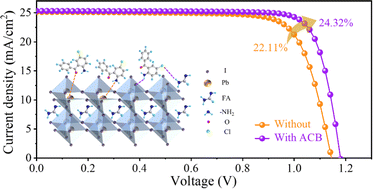2-Amino-5-chlorobenzophenone passivating perovskite films using multiple functional groups towards high-performance solar cells†
Abstract
Surface defects of perovskite films are considered to be a source of carrier nonradiative recombination in perovskite solar cells (PSCs) that causes not only the degradation of power conversion efficiency (PCE) but also instability. In this study, an organic small molecule, 2-amino-5-chlorobenzophenone (ACB), is employed to passivate the surface defects of (FAPbI3)0.95(MAPbBr3)0.05 perovskite films. The O of the carbonyl group (–C![[double bond, length as m-dash]](https://www.rsc.org/images/entities/char_e001.gif) O) and the N of the amino group (–NH2) in ACB form a coordinate bond with the uncoordinated Pb2+ of the perovskite to passivate this defect. The –NH2 and –Cl groups in ACB can also form a hydrogen bond with the perovskite, which inhibits the degradation of the perovskite films. PSCs with ACB passivation possess lower defect state density and better photoelectric properties. Therefore, PCE of the PSCs is increased from 22.11% to 24.32% by ACB passivation. Furthermore, the ambient stability of the PSCs is also enhanced. The unencapsulated PSCs with ACB passivation maintain 90% of their initial PCE after being stored for 1440 h under ambient conditions.
O) and the N of the amino group (–NH2) in ACB form a coordinate bond with the uncoordinated Pb2+ of the perovskite to passivate this defect. The –NH2 and –Cl groups in ACB can also form a hydrogen bond with the perovskite, which inhibits the degradation of the perovskite films. PSCs with ACB passivation possess lower defect state density and better photoelectric properties. Therefore, PCE of the PSCs is increased from 22.11% to 24.32% by ACB passivation. Furthermore, the ambient stability of the PSCs is also enhanced. The unencapsulated PSCs with ACB passivation maintain 90% of their initial PCE after being stored for 1440 h under ambient conditions.

- This article is part of the themed collection: 2023 Journal of Materials Chemistry C HOT Papers


 Please wait while we load your content...
Please wait while we load your content...